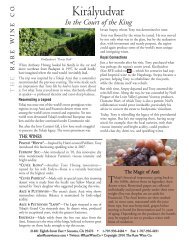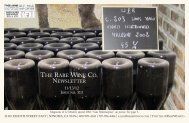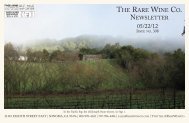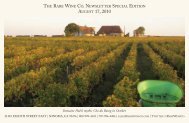leacock online i.qxp - The Rare Wine Co.
leacock online i.qxp - The Rare Wine Co.
leacock online i.qxp - The Rare Wine Co.
You also want an ePaper? Increase the reach of your titles
YUMPU automatically turns print PDFs into web optimized ePapers that Google loves.
Online Edition<br />
THE RARE WINE CO.<br />
A Taste of History — June 7, 2009<br />
21481 EIGHTH STREET EAST SONOMA, CA 95476 800-999-4342 707-996-4484 SALES@RAREWINECO.COM<br />
<strong>The</strong>se HMB Terrantezes are the most compelling—and potentially valuable—Madeiras from<br />
Christie’s December 2008 Leacock auction.
THE RARE WINE CO.<br />
21481 EIGHTH STREET EAST SONOMA, CA 95476 800-999-4342/707-996-4484 email us at sales@rarewineco.com<br />
LEACOCK FAMILY MADEIRA TASTING<br />
On June 7, 2009, in San Francisco, we will host a<br />
Madeira tasting of profound importance. <strong>The</strong> wines are<br />
all from the Leacock family collection that was auctioned<br />
last December in London.<br />
<strong>The</strong> provenance of the wines is sufficient cause for interest.<br />
But the full significance of the sale—and our June 7th<br />
tasting—goes far beyond that: it’s the first time in more<br />
than three decades that so much truly rare and iconic<br />
Madeira has come on the market. And as the history of Madeira continues<br />
its slow march, it will almost certainly be the last.<br />
�<br />
O<br />
n December 11, 2008, William Leacock, the last of the Madeira Leacocks,<br />
sold his wine collection at Christies in London. Other former<br />
members of the Madeira trade have sold wine at auction, but since records<br />
have been kept, there’s never been a sale even remotely like this one.<br />
For one thing, his collection represented everything that belonged to the<br />
Leacocks, major players in the Madeira trade for 250 years, longer than<br />
any other British family. William was the only son of Edmund Leacock,<br />
who had bought out his brother Julian’s interest in the business in 1953.<br />
All the wine ended up with William.<br />
A Taste of History<br />
An Epic Tasting of the Leacock Family’s Madeiras<br />
Bottles from the Leacock sale.<br />
page 1<br />
But there’s more. <strong>The</strong> Leacocks’ collection was the crème de<br />
la crème—the result of a consolidation that began in 1913.<br />
This was the year when the Leacocks joined with the<br />
Blandys—the second oldest British family in the Madeira<br />
trade—to found a company called the Madeira <strong>Wine</strong><br />
Association (MWA). Over the next four decades, almost<br />
every Madeira shipper of note was absorbed into the MWA,<br />
pooling not only their brands but their old wines. Quietly,<br />
with an eye to the future, the Leacocks and Blandys pulled<br />
out a few bottles of all the greatest wines for their own collections.<br />
<strong>The</strong>re has never been a major auction of Blandy family-owned wines. <strong>The</strong><br />
Blandys had more children than the Leacocks, which led to more dividing<br />
of the family jewels over the generations. No Blandy descendent has ever<br />
sold more than a few bottles at a time, but in one shot William Leacock<br />
sold virtually all the Madeira he inherited: twenty-five unique and irreplaceable<br />
wines, of which two-thirds were from the 18th or 19th centuries.<br />
<strong>The</strong> Leacock Madeiras have blue chip written all over them—how could they<br />
not, coming from one of the most prominent families in the Madeira trade?<br />
But in surveying the catalogue, the importance of many of the wines would<br />
not have been obvious to most readers. In fact, some of the most mythic, and<br />
potentially valuable, wines in the sale received little or no comment. V
<strong>The</strong> Mythic Quinta da Paz<br />
Among the hidden gems in the sale was 1845<br />
Lomelino Quinta da Paz , a wine we had lusted after<br />
for as long as we knew of its existence. But we had<br />
never had the chance because the last bottle came up<br />
at auction 22 years ago.<br />
This wine came into the possession of the Leacocks<br />
and Blandys in the 1930s and was cherished by generations<br />
of both families. In 1971, Graham Blandy gave<br />
each of his children two bottles, calling them “museum<br />
pieces.” Prior to the Leacock sale, only seven bottles<br />
are known to have ever appeared at auction: at least<br />
two came from Blandy children and two more from<br />
Tom Mullins, who ran the MWA for a half century. <strong>The</strong>se bottles brought<br />
among the highest Madeira auction prices for their time.<br />
A.G. Pacheco<br />
<strong>The</strong> pre-phylloxera A.G. Pacheco challenges the Quinta<br />
da Paz for rarity. Since the 1970s, we know of only four<br />
bottles having been sold at auction, the last in 1986.<br />
Bottled by the Madeira <strong>Wine</strong> Association in 1927, the<br />
bottles previously sold had come from Tom Mullins. In<br />
1978 a bottle sold for the same price as a bottle of 1789<br />
Avery's Câma do Lobos in the same sale.<br />
But, ironically, the Pacheco was overlooked by casual<br />
bidders at Christies, having been “lost” in the catalogue<br />
between 1927 and 1928 vintage wines, with nary a note<br />
of its distinction.<br />
<strong>The</strong> Leacock Family Madeiras<br />
<strong>The</strong> Earliest Bastardo Known to Exist<br />
Another star in the sale was the 1836 Lomelino<br />
Bastardo, a previously unknown wine. It undoubtedly<br />
came into the Leacocks’ possession when Lomelino<br />
joined the Madeira <strong>Wine</strong> Association in the 1930s.<br />
At age 173, this is not only the oldest vintage Bastardo<br />
known to exist, it is a wine of mindboggling richness.<br />
From a pre-sale tasting, Michael Broadbent wrote:<br />
“����� Tawny-bronze colour with pronounced yellow-green<br />
rim; though typically tangy; totally different,<br />
unfamiliar, spirity bouquet; very sweet, soft texture,<br />
lovely flavour." Also from a pre-sale tasting, erobertparker.com’s Neal Martin<br />
wrote: “96 rating ... heavenly bouquet ... wonderful balance and subtlety ...<br />
just gets better and better in the glass.”<br />
Eugenia de Bianchi Henriques’ <strong>Wine</strong><br />
While the Bastardo was previously unknown, the 1868 “EBH” Very Old Boal<br />
is famous—or at least it is to serious students<br />
of Madeira wine history. <strong>The</strong> initials stand<br />
for Eugenia de Bianchi Henriques, who had<br />
two famous grandfathers: on her mother’s<br />
side, Tarquinio Torquato da Camera<br />
Lomelino, the founder of Lomelino, and on<br />
her father’s, Carlo de Bianchi, who ran<br />
Lomelino after Tarquinio’s death. She was<br />
also the aunt of Noël <strong>Co</strong>ssart and wife of<br />
Tiburcio Henriques, scion of Câma do<br />
Lobos’ important Henriques family. V<br />
page 2<br />
<strong>The</strong> de Bianchi family: Carlo de Bianchi<br />
(front row), Eugenia de Bianchi (middle of<br />
second row) and Noël <strong>Co</strong>ssart’s mother<br />
Anna Maria (top row).
<strong>The</strong> Leacock Family Madeiras<br />
Eugenia de Bianchi Henriques’ <strong>Wine</strong> (<strong>Co</strong>nt.)<br />
Such connections explain the great Boals that<br />
appeared under Eugenia’s initials from vintages like<br />
1869, 1870 and 1893. But the 1868 is the most<br />
revered. In his Great Vintage <strong>Wine</strong> Book, Michael<br />
Broadbent wrote: “�����. Translucent, ethereal,<br />
herbaceous, full, rich, lovely texture, great<br />
length ... A famous wine, surpassed only by the<br />
1862 (HMB) Terrantez.”<br />
But while the EBH 1868 is famous, it’s also<br />
incredibly rare. Since 1988, it had appeared only<br />
three times at auction: a single bottle in 1999,<br />
three bottles in 2006 and three bottles in 2008<br />
(which we purchased). But over the course of five<br />
minutes on December 11, 2008, bidders had the<br />
chance to seize an unheard-of 23 bottles of this<br />
iconic wine—the last bottles owned by the Leacock family.<br />
<strong>The</strong> Terrantez Mystery<br />
But the most important lots in the entire sale were possibly the 48 bottles<br />
of undated Terrantez from the legendary Henriques Menèzes Borges.<br />
Though the wine is clearly vintage Terrantez, and of celestial quality, the<br />
bottles bear no date, merely “TERRANTEZ H M B” on two lines.<br />
Until his death in 1916, Borges was arguably Madeira’s greatest judge of<br />
Terrantez, best known for the 1846 and 1862 vintages that bore his name<br />
and initials. Despite the absence of a date on the bottles, William<br />
Leacock’s HMB Terrantez rivals those two legendary wines.<br />
Notes from the presale tastings bear this out. Michael Broadbent, for<br />
example, wrote: "����� Medium-deep bronze colour with apple green<br />
rim; tangy. High toned bouquet; very rich, very powerful, lovely texture<br />
and hot dry finish. Magnificent wine."<br />
And from Neal Martin (erobertparker.com): “96 rating ... a delectable barley<br />
sugar scented nose ... harmonious, very honeyed ... a beautiful Madeira.”<br />
But the question remains, what vintage of H.M. Borges Terrantez is in<br />
those bottles? Unfortunately, William Leacock doesn’t know; the wine was<br />
acquired by his father or grandfather. Nor does Christie’s know. <strong>The</strong> sale<br />
catalogue stated that the vintage is “believed 1920s,” but during the presale<br />
tasting, this was corrected to “bottled in the 1920s,” with a possible<br />
vintage in the mid to late 1800s.<br />
Inevitably, the speculation zeroes in on 1862: the Terrantez considered not<br />
only Borges’ best, but one of the greatest Madeiras ever made, and a wine<br />
that in recent years has regularly sold for between $3000 and $5000 a bottle.<br />
But why 1862? Apart from the staggering quality of the wine in the<br />
Leacock bottles, we’re riveted by the stenciling, because of all the H.M.<br />
Borges Terrantezes we have ever seen—including 1760, 1790, 1846, 1862,<br />
1877, 1890, 1899 and 1900 —only 1862 is typically stenciled “Terrantez<br />
HMB” on separate lines as are the<br />
Leacock bottles.<br />
At left, a Leacock-owned bottle of HMB<br />
Terrantez and at right a bottle of HMB<br />
Terrantez 1862.<br />
page 3<br />
<strong>The</strong> stenciling of the Leacock bottles also<br />
fits the description of two bottles belonging<br />
to the late Tom Mullins—longtime<br />
Madeira <strong>Wine</strong> Association Director—<br />
that were sold at Christie’s in 1982 as<br />
“believed to be 1862.”
<strong>The</strong> Leacock Family Madeiras<br />
1928 Leacock Verdelho “EEL” (Edmund Erskine Leacock)<br />
A wine we had not seen before for the likely reason that it was<br />
bottled exclusively for the Leacock family. Michael Broadbent:<br />
"����. Medium pale green-tinged amber, pale yellow-green<br />
rim; rich, 'meaty' bouquet; medium-sweet, rich, good length,<br />
dry finish."<br />
1881 Leacock Terrantez Madeira<br />
Terrantezes are rarely seen after Phylloxera arrived in the early<br />
1870s. Michael Broadbent: “���� ... fine colour; mediumsweet,<br />
tangy, distinctive, very dry finish." Neal Martin: “93 rating ... Clear<br />
amber hue with a noticeable gold/lemon rim. <strong>The</strong> nose is fresh and lively,<br />
quite feminine, citrus fruits at first, mandarin and a little spice. <strong>The</strong> palate is<br />
medium-bodied, good acidity, fresh and zesty, quite lithe with orange zest<br />
and a touch of strawberry. Very elegant and refined. Lovely.”<br />
Jancis Robinson’s Purple Pages: “... a soft, milk or white chocolate<br />
aroma. <strong>The</strong> taste was perfect. Beautifully sweet, but not rich<br />
or cloying. Refreshing, zesty and cleansing.”<br />
1825 Leacock Madeira Seco<br />
Bottled in 1932, after 107 years in cask. Michael Broadbent:<br />
“Palish, open, apple-green rim; tangy; medium-sweet attractive<br />
flavour leading to a slightly drier finish." Neal Martin: “92 rating<br />
... a lovely hazelnut nose ... quite sweet on the entry and then<br />
bang! That razor-sharp acidity really hits you and leads to a spicy,<br />
walnut-tinged finish ... Nice focus, very tangy towards the finish.”<br />
1934 Leacock “SJ” Madeira<br />
Another early 20th century rarity, this one from the Leacock<br />
family’s own vineyard, St. John’s, on the outskirts of Funchal.<br />
<strong>Wine</strong>s may be sold and delivered only to persons who are at least 21 years old. All wines are sold in California and title passes to the<br />
buyer in California. We make no representation to the legal rights of anyone to ship or import wines into any state outside of<br />
California. We are not responsible for typographical errors. All items and prices subject to availability. Request a copy of our terms of<br />
sale or read them at www.rarewineco.com. * indicates pre-arrival. Issued 14 times yearly. © 2009 <strong>The</strong> <strong>Rare</strong> <strong>Wine</strong> <strong>Co</strong>.<br />
page 4<br />
Leacock Malvazia 'VMA' Madeira<br />
A rare 19th-century Malmsey believed bottled between 1910 and<br />
1930.<br />
1890 Leacock Sercial<br />
Very rare; a wine that's never before appeared at auction or in any<br />
records we've seen. Michael Broadbent: “�����. Medium<br />
amber with pronounced yellow-green rim; superb, ethereal, tangy<br />
bouquet; swingingly dry ....” Neal Martin: “95 rating ... complex<br />
nose with hazelnut, cooking apple and tangerine, smooth and<br />
subtle on the entry, perhaps the caramel element a little too pronounced<br />
compared to others and yet with sublime balance and<br />
freshness on the finish. It is a beautiful Sercial ... an ephemeral finish.<br />
Very feminine and sensuous.”<br />
1896 HFS E Madeira<br />
1895 HFS JPW Madeira<br />
A pair of intriguing rarities. Our still-to-be-confirmed suspicion<br />
is that these wines were laid down for two of the sons of John<br />
Milburne Leacock: Edmund Erskine (born 1891) and Julian Philip (born<br />
1893).<br />
Leacock “A” Madeira<br />
An ancient wine, possibly Sercial, that Michael Broadbent<br />
believes may be of the 1860 vintage. He writes: "��� .... razorsharp<br />
old Sercial character, possible of the 1860 vintage; medium<br />
sweet entry, very dry finish, good texture and flavour." Jancis<br />
Robinson’s Purple Pages: “<strong>The</strong> nose was savoury and beautifully<br />
caramelised, with butterscotch and vanilla. On revisiting it, there<br />
was fudge, sweet vanilla biscuits and some chocolate. It was the<br />
first wine we tasted and seemed quite spirity in the mouth, but<br />
with a delicious balance of sweet and savour – almost salty.”
I<br />
An Epic Tasting<br />
<strong>The</strong> Leacock Family Madeiras<br />
n all of life’s pursuits there are opportunities<br />
where we know we must act—and if we<br />
don’t, we’re likely to regret it. This is particularly<br />
so with something as ephemeral as Madeira, a<br />
wine that has been vanishing before the world’s<br />
eyes for the past century.<br />
Since we bought the hundreds of cases of old<br />
Madeira that launched our business in 1988, we’ve<br />
acted decisively when important Madeira opportunities<br />
have presented themselves. <strong>The</strong> Leacock sale<br />
was no exception. Knowing there would never be<br />
another chance—and being able to draw on our<br />
25 years of exhaustive research on many of these<br />
wines—we bought virtually every wine of importance<br />
in the sale.<br />
On the afternoon of June 7, 2009, we will host a<br />
momentous tasting of the wines. <strong>The</strong> setting will<br />
be particularly appropriate: the art nouveau<br />
Peacock Terrace of the Grand Café in San<br />
Francisco’s Hotel Monaco. <strong>The</strong> Peacock Terrace<br />
was named by Forbes Magazine one of<br />
America’s thirteen finest private dining rooms.<br />
<strong>The</strong> tasting will include the 14 irreplaceable<br />
Madeiras at right. Appetizers will accompany the<br />
wines. And because many of these Madeiras will<br />
be offered for sale later this year, those attending<br />
will have priority for purchasing them.<br />
<strong>The</strong> cost for the event is $495 + tax per person.<br />
�<br />
1836 Lomelino Bastardo<br />
1845 Quinta da Paz<br />
1868 EBH Very Old Boal<br />
HMB Terrantez (undated)<br />
A.G. Pacheco Madeira<br />
1825 Leacock Seco<br />
1881 Leacock Terrantez<br />
1890 Leacock Sercial<br />
1895 HFS ‘JPW’<br />
1896 HFS ‘E’<br />
1928 Leacock Verdelho<br />
1934 Leacock 'SJ'<br />
Leacock 'A’<br />
Leacock Malvazia 'VMA'<br />
<strong>The</strong> Leacock Family Madeiras<br />
<strong>Co</strong>st per person: $495 plus tax<br />
Date: Sunday, June 7, 2009, Time: 2:00 pm.<br />
Place: Grand Cafe, Hotel Monaco, 501 Geary Street, San Francisco, CA 94102<br />
For reservations, call <strong>The</strong> <strong>Rare</strong> <strong>Wine</strong> <strong>Co</strong>. (800) 999-4342 or email us at sales@rarewineco.com.<br />
Payment in full by credit card required to secure.<br />
page 5








